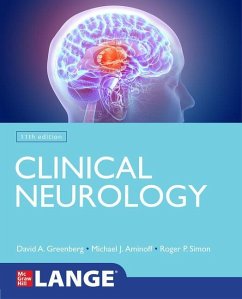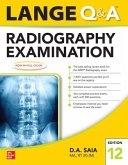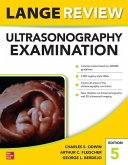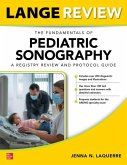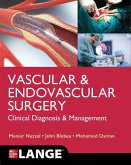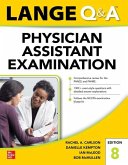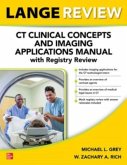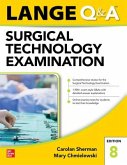- Broschiertes Buch
- Merkliste
- Auf die Merkliste
- Bewerten Bewerten
- Teilen
- Produkt teilen
- Produkterinnerung
- Produkterinnerung
Publisher's Note: Products purchased from Third Party sellers are not guaranteed by the publisher for quality, authenticity, or access to any online entitlements included with the product. The clearest, most concise coverage of one of the most complex topics in medicine-updated with the latest advances in the field Clinical Neurology, Eleventh Edition, provides a comprehensive overview of basic and clinical neurology in a concise, digestible format. It links clinical neuroscience to current approaches for accurately diagnosing and effectively treating neurologic disorders. Covering all the…mehr
Andere Kunden interessierten sich auch für
![Lange Q & A Radiography Examination 12e Lange Q & A Radiography Examination 12e]() D.A. SaiaLange Q & A Radiography Examination 12e75,99 €
D.A. SaiaLange Q & A Radiography Examination 12e75,99 €![Lange Review Ultrasonography Examination: Fifth Edition Lange Review Ultrasonography Examination: Fifth Edition]() Charles OdwinLange Review Ultrasonography Examination: Fifth Edition112,99 €
Charles OdwinLange Review Ultrasonography Examination: Fifth Edition112,99 €![LANGE Review: The Fundamentals of Pediatric Sonography: A Registry Review and Protocol Guide LANGE Review: The Fundamentals of Pediatric Sonography: A Registry Review and Protocol Guide]() Jenna LaquerreLANGE Review: The Fundamentals of Pediatric Sonography: A Registry Review and Protocol Guide75,99 €
Jenna LaquerreLANGE Review: The Fundamentals of Pediatric Sonography: A Registry Review and Protocol Guide75,99 €![Lange Vascular and Endovascular Surgery: Clinical Diagnosis and Management Lange Vascular and Endovascular Surgery: Clinical Diagnosis and Management]() Munier NazzalLange Vascular and Endovascular Surgery: Clinical Diagnosis and Management133,99 €
Munier NazzalLange Vascular and Endovascular Surgery: Clinical Diagnosis and Management133,99 €![Lange Q&A Physician Assistant Examination, Eighth Edition Lange Q&A Physician Assistant Examination, Eighth Edition]() Rachel CarlsonLange Q&A Physician Assistant Examination, Eighth Edition94,99 €
Rachel CarlsonLange Q&A Physician Assistant Examination, Eighth Edition94,99 €![Lange Review: CT Clinical Concepts and Imaging Applications Manual with Registry Review Lange Review: CT Clinical Concepts and Imaging Applications Manual with Registry Review]() Michael L. GreyLange Review: CT Clinical Concepts and Imaging Applications Manual with Registry Review56,99 €
Michael L. GreyLange Review: CT Clinical Concepts and Imaging Applications Manual with Registry Review56,99 €![Lange Q&A Surgical Technology Examination, Eighth Edition Lange Q&A Surgical Technology Examination, Eighth Edition]() Carolan ShermanLange Q&A Surgical Technology Examination, Eighth Edition77,99 €
Carolan ShermanLange Q&A Surgical Technology Examination, Eighth Edition77,99 €-
-
-
Publisher's Note: Products purchased from Third Party sellers are not guaranteed by the publisher for quality, authenticity, or access to any online entitlements included with the product. The clearest, most concise coverage of one of the most complex topics in medicine-updated with the latest advances in the field Clinical Neurology, Eleventh Edition, provides a comprehensive overview of basic and clinical neurology in a concise, digestible format. It links clinical neuroscience to current approaches for accurately diagnosing and effectively treating neurologic disorders. Covering all the advances in molecular biology and genetics, this popular guide emphasizes history-taking and neurologic examination as the cornerstones of diagnosis. All information is thoroughly up-to-date and presented as a practice-oriented approach to neurology based on the patient's presenting symptoms or signs. Features: . 350+ tables and figures . Chapter outlines providing overview of each topic . Treatment protocols reflecting the most recent advances in the field . Step-by-step review of the neurologic examination
Hinweis: Dieser Artikel kann nur an eine deutsche Lieferadresse ausgeliefert werden.
Hinweis: Dieser Artikel kann nur an eine deutsche Lieferadresse ausgeliefert werden.
Produktdetails
- Produktdetails
- Verlag: McGraw-Hill Education
- 11 ed
- Seitenzahl: 464
- Erscheinungstermin: 18. Dezember 2020
- Englisch
- Abmessung: 232mm x 187mm x 27mm
- Gewicht: 830g
- ISBN-13: 9781260458350
- ISBN-10: 1260458350
- Artikelnr.: 59258471
- Herstellerkennzeichnung
- Libri GmbH
- Europaallee 1
- 36244 Bad Hersfeld
- 06621 890
- Verlag: McGraw-Hill Education
- 11 ed
- Seitenzahl: 464
- Erscheinungstermin: 18. Dezember 2020
- Englisch
- Abmessung: 232mm x 187mm x 27mm
- Gewicht: 830g
- ISBN-13: 9781260458350
- ISBN-10: 1260458350
- Artikelnr.: 59258471
- Herstellerkennzeichnung
- Libri GmbH
- Europaallee 1
- 36244 Bad Hersfeld
- 06621 890
McGraw-Hill authors represent the leading experts in their fields and are dedicated to improving the lives, careers, and interests of readers worldwide
Chapter 1. NeurologicHistory & Examination
Neurologic examination ofsphincter function
Chapter 2. InvestigativeStudies
Neuromuscular imaging studies
Update on ultrasonography forneuromuscular diagnosis
Chapter 3. Coma
Introduction
Role of prefrontal cortex in consciousness
Causes of coma
Spontaneous intracranialhypotension as a cause of coma
Persistent vegetative state
New imaging insights intopersistent vegetative & minimally conscious states
Treatment of traumatic vegetative &minimally conscious states with
amantadine
Chapter 4. ConfusionalStates
Drugs
Serotonin syndrome
Electrolyte disorders
Antidepressant-inducedhyponatremia
Endocrine & metabolic disorders
Mechanisms of impairedhypoglycemia sensing in treated diabetes
Nutritional disorders
Furosemide-induced thiaminedeficiency
Organ system failure
ICU delirium
Postoperative cognitivedysfunction
Meningitis, encephalitis & sepsis
Mechanism of N. meningitidis vascular spread
Dysregulated host inflammatoryresponse in tuberculous meningitis
CSF findings in HIV-infectedpatients with tuberculous meningitis
Tick-borne encephalitis & (re-emergent)yellow fever
Nipah virus encephalitis
Updated diagnostic testing forviral encephalitis
New recommendation on empiricaltreatment of toxoplasmosis in AIDS
Fexinidazole for treatment of Africantrypanosomiasis
Mechanism of meningeal invasion inleukemia
Chapter 5. Dementia& Amnestic Disorders
Introduction
Somatic neuronal mutations in aging and neurodegeneration
Differential diagnosis
Biomarker-based diagnostic algorithms for dementia syndromes
Neurodegenerativeproteinopathies
Tau folding in Alzheimer vs. Pickdisease
Tau-disrupted nucleocytoplasmictransport in Alzheimer disease pathogenesis
Contrasting mechanisms ofaggregate toxicity in neurodegeneration
Herpes simplex virus infection andAlzheimer disease
Inflammation in Alzheimer diseasepathogenesis
Meningeal lymphatics (glymphatics)in Alzheimer disease pathogenesis
Blood pressure and risk of Alzheimerdisease
Relation between epilepsy anddementia
Exercise training in dementia
Sex differences in Alzheimerdisease
Spatial navigation deficits asearly signs of Alzheimer disease
Subjective cognitive decline in relationto Alzheimer disease
Update on biomarkers for Alzheimerdisease
Concomitant neurodegenerativeproteinopathies
Update on clinical trials oftreatments for Alzheimer disease (eg,
solanezumab, verubecestat)
Clinical and pathologicalcorrelates of primary progressive aphasia variants
New consensus guidelines fordiagnosis & treatment of dementia with Lewy
bodies
Skin prions in Creutzfeldt-Jakobdisease infectivity and diagnosis
Other cerebral disorders
Shunting response to gait vs. dementia in normal pressurehydrocephalus
Normal pressure hydrocephalus vs.neurodegenerative ventriculomegaly
Mild traumatic brain injury & dementia
Systemic disorders
Subclinical hyperthyroidism &dementia
Pseudodementia
Features of memory impairment in depression
Amnestic syndromes
Update on antibody-mediatedencephalitis antigens & treatment
Chapter 6. Headache& Facial Pain
Migraine
Triptans, SSRIs & serotoninsyndrome
CGRP receptor-blocking monoclonalantibodies (eg, erenumab, fremanezumab)
Prochlorperazine plusdiphenhydramine vs. hydromorphone for IV migraine
therapy
Vagus nerve stimulation as acute therapyfor migraine
Reconsideration of medicationoveruse headache
Update on sustained release drugs
Safety of migraine drugs in pregnancyand breast-feeding
Cluster headache
CGRPreceptor-blocking monoclonal antibodies
Giant cell arteritis
Tocilizumab for treatment ofgiant-cell arteritis
Intracranial mass
Molecular classification of braintumors
Subventricular zone origin ofglioblastoma multiforme
Nivolumab plus ipilimumab formelanoma brain metastases
Chapter 7. Neuro-OphthalmicDisorders
Update on imaging of optic nervedisorders (optical coherence tomography)
Nonarteritic anterior ischemic optic neuropathy inobstructive sleep apnea
Erectile dysfunction drugs & nonarteritic anterior ischemicoptic neuropathy
Updated consensus management ofpseudotumor cerebri
Update on imaging of giant cellarteritis (ultrasound, MRI, PET)
Charles Bonnet syndrome incortical blindness
Chapter 8. Disordersof Equilibrium
New Figure: Sites of involvement in peripheral vestibular disorders
Peripheral vestibular disorders
Self-treatment of benign paroxysmal positional vertigo
Cerebellar & central vestibulardisorders
Autoimmune septin-5 cerebellarataxia
Cerebellar histiocytosis
Sensory ataxias
Nonataxic symptoms in FriedreichAtaxia
Chapter 9. MotorDisorders
Spinal cord disorders
Ibudilast for treatment of progressivemultiple sclerosis
Simvastatin for cognitivedysfunction in secondary progressivemultiple
sclerosis
Clinical differentiation oftransverse myelitis etiologies
Circumferential resectioncord-compressing tumors (vs. decompressive
laminectomy)
Anterior horn cell disorders
Kinesin family member 5A (KIF5A) mutationsassociated with ALS
Edaravone for treatment of ALS
Nusinersen for treatment oflater-onset spinal muscular atrophy
Disorders of peripheral nerve
Critical illness neuromyopathy(updating critical illness polyneuropathy) &
management
Disorders of neuromuscular transmission
Bilevel positive airway pressure(BiPAP) for myasthenic crisis
Tensilon®replaced by Enlon® (both edrophonium) for myasthenia testing
Eculizumab for treatment ofmyasthenia gravis
Chapter 10. SensoryDisorders
New Table: Pharmacologic Treatment of Pain
Approach to diagnosis
Neuropathic itch: causes &treatment
Polyneuropathies
Guillain-Barrésyndrome associated with bone and digestive organ surgery
Autoantibodies in chronic inflammatory demyelinatingpolyradiculoneuropathy
Polyneuropathy with monoclonal gammopathy of uncertain significance
Fluoroquinolone-induced polyneuropathy
Patisiran treatment of hereditarytransthyretin-mediated amyloidosis
Chapter 11. MovementDisorders
Parkinsonism
LRRK2 activation in idiopathic Parkinson disease
Postural tremor subtypes in Parkinson disease
Light therapy treatment of Parkinsondisease
Chapter 12. Seizures& Syncope
Seizures
Update on sustained release drugs
Safety of anticonvulsant drugs inpregnancy and breast-feeding
Newly approved anticonvulsantdrugs: clobazam, eslicarbazepine, perampanel,
Cannabidiol for treatment of Lennox-Gastaut& Dravet syndromes
Hypothermia not associated with betteroutcome in status epilepticus
No increased risk of seizures withattention-deficit disorder medications
Syncope
Relative efficacy of nonpharmacologicinterventions for orthostatic
hypotension
Chapter 13. Stroke
Approach to diagnosis
Updated epidemiology ofcerebrovascular disease
Focal cerebral ischemia-approach to diagnosis
Temporal trends in ischemic stroke subtypes
Five-year risk of stroke after TIAor minor ischemic stroke (2018 study)
Factors associated with emergencyroom misdiagnosis of stroke
Focal cerebral ischemia-pathophysiology
Skull bone marrow in post-strokeinflammatory response
Focal cerebral ischemia-etiology
New perspectives on cerebral smallvessel disease
Preeclampsia, posterior reversible encephalopathy syndrome, and stroke
Late-life systolic and diastolicblood pressure and risk of stroke
Intra-ictal blood pressure and poststroke cognitive impairment
Blood lipid profiles in relationto stroke subtypes
Psychological stress as a risk factor for stroke
Sepsis as a risk factor for stroke
Update on genetics, epidemiology& management of cerebrovascular
fibromuscular dysplasia
Update on ischemic stroke incancer patients and its treatment
Stroke risk in occult and manifest cancers
Biopsy vs. imaging findings in primaryCNS vasculitis
Update on patent foramen ovaleclosure for cryptogenic stroke
Effects of sex and aura on strokerisk in migraine
Role of paradoxical embolism instroke in migraineurs
Presentations and treatment updatein cerebral venous and sinus thrombosis
Focal cerebral ischemia-prevention & treatment
LDL cholesterol target levels forsecondary stroke prevention
Stroke prevention in the veryelderly
Hypercoagulability workup for nonatheroscleroticischemic stroke
Aspirin for primary stroke preventionin diabetes mellitus
Diagnosis & management of theantiphospholipid syndrome in stroke prevention
Embolic stroke after leftventricular endocardial ablation
American Heart Association 2018 guidelines for management of acuteischemic
stroke
Aspirin ± clopidogrel for acute ischemic strokeand TIA
Betrixaban vs. enoxaparin forstroke prophylaxis in hospitalized patients
Ezetimibe for stroke prevention inacute coronary syndrome
Rivaroxaban ±aspirin for secondary stroke prevention
Rivaroxaban vs.aspirin for secondary prevention after cryptogenic stroke
Andexanet alfa for reversing bleeding from factor Xa inhibitor treatment
Timing for initiating statin therapy after acute ischemic stroke
Warfarin vs. vitamin K antagonists for embolic stroke prevention inatrial
fibrillation
Reappraisal of endarterectomy forasymptomatic carotid stenosis
Leukoaraiosis & risk of hemorrhage after thrombolysis
Tenecteplase versus alteplase thrombolysis before thrombectomy forischemic
stroke
Safety of thrombolysis in patients on non-vitamin K antagonist
oralanticoagulants
Time to endovascular treatment and outcome in acute ischemic stroke
Endovascular thrombectomy 6-24hours after stroke onset
MRI-guided thrombolysis for stroke withunknown time of onset
Endovascular therapy for distalintracranial occlusions
Effect of intravenous thrombolysisprior to mechanical thrombectomy on
stroke outcome
Effect of interhospital transferon stroke outcome after thrombectomy
EmboTrap thrombectomy for acuteischemic stroke from large-vessel occlusion
Conscious sedation vs. localanesthesia for endovascular treatment of stroke
Cervical nerve transfer for limbparalysis after stroke
Focal cerebral ischemia-complications & rehabilitation
Mechanisms of cardiac complications after stroke
Hyperglycemia & post-strokeinfection
Microbiological etiologies of pneumonia complicating stroke
Post-stroke fatigue and itstreatment
Post-stroke anxiety subtypes
Long-term risk of post-strokeseizures
Mechanisms of motor compensationafter stroke
Robotic exosuits for strokerehabilitation
Intracerebral hemorrhage
Etiology of deep vs. superficial cerebellar hemorrhage
Update on etiology & outcome of perimesencephalic hemorrhage
Risk of intracerebral hemorrhage from warfarin vs. direct
oralanticoagulants
Effects of statins on incidence of intracerebral and subarachnoidhemorrhage
Blood pressure target to prevent brain ischemia after
intracerebralhemorrhage
Genetics of intracranial aneurysms
Medical vs. interventional therapy for unruptured brain AVMs: results
ofrandomized trial
Spetzler-Martin grading scale & treatment of brain AVMs
Update on genetics and bleedingrisk of cranial cavernous malformations
Global cerebral ischemia
Early hyperoxia and neurologicalfunction after cardiac arrest
Epinephrine & neurological outcomeafter cardiac arrest
Neurologic examination ofsphincter function
Chapter 2. InvestigativeStudies
Neuromuscular imaging studies
Update on ultrasonography forneuromuscular diagnosis
Chapter 3. Coma
Introduction
Role of prefrontal cortex in consciousness
Causes of coma
Spontaneous intracranialhypotension as a cause of coma
Persistent vegetative state
New imaging insights intopersistent vegetative & minimally conscious states
Treatment of traumatic vegetative &minimally conscious states with
amantadine
Chapter 4. ConfusionalStates
Drugs
Serotonin syndrome
Electrolyte disorders
Antidepressant-inducedhyponatremia
Endocrine & metabolic disorders
Mechanisms of impairedhypoglycemia sensing in treated diabetes
Nutritional disorders
Furosemide-induced thiaminedeficiency
Organ system failure
ICU delirium
Postoperative cognitivedysfunction
Meningitis, encephalitis & sepsis
Mechanism of N. meningitidis vascular spread
Dysregulated host inflammatoryresponse in tuberculous meningitis
CSF findings in HIV-infectedpatients with tuberculous meningitis
Tick-borne encephalitis & (re-emergent)yellow fever
Nipah virus encephalitis
Updated diagnostic testing forviral encephalitis
New recommendation on empiricaltreatment of toxoplasmosis in AIDS
Fexinidazole for treatment of Africantrypanosomiasis
Mechanism of meningeal invasion inleukemia
Chapter 5. Dementia& Amnestic Disorders
Introduction
Somatic neuronal mutations in aging and neurodegeneration
Differential diagnosis
Biomarker-based diagnostic algorithms for dementia syndromes
Neurodegenerativeproteinopathies
Tau folding in Alzheimer vs. Pickdisease
Tau-disrupted nucleocytoplasmictransport in Alzheimer disease pathogenesis
Contrasting mechanisms ofaggregate toxicity in neurodegeneration
Herpes simplex virus infection andAlzheimer disease
Inflammation in Alzheimer diseasepathogenesis
Meningeal lymphatics (glymphatics)in Alzheimer disease pathogenesis
Blood pressure and risk of Alzheimerdisease
Relation between epilepsy anddementia
Exercise training in dementia
Sex differences in Alzheimerdisease
Spatial navigation deficits asearly signs of Alzheimer disease
Subjective cognitive decline in relationto Alzheimer disease
Update on biomarkers for Alzheimerdisease
Concomitant neurodegenerativeproteinopathies
Update on clinical trials oftreatments for Alzheimer disease (eg,
solanezumab, verubecestat)
Clinical and pathologicalcorrelates of primary progressive aphasia variants
New consensus guidelines fordiagnosis & treatment of dementia with Lewy
bodies
Skin prions in Creutzfeldt-Jakobdisease infectivity and diagnosis
Other cerebral disorders
Shunting response to gait vs. dementia in normal pressurehydrocephalus
Normal pressure hydrocephalus vs.neurodegenerative ventriculomegaly
Mild traumatic brain injury & dementia
Systemic disorders
Subclinical hyperthyroidism &dementia
Pseudodementia
Features of memory impairment in depression
Amnestic syndromes
Update on antibody-mediatedencephalitis antigens & treatment
Chapter 6. Headache& Facial Pain
Migraine
Triptans, SSRIs & serotoninsyndrome
CGRP receptor-blocking monoclonalantibodies (eg, erenumab, fremanezumab)
Prochlorperazine plusdiphenhydramine vs. hydromorphone for IV migraine
therapy
Vagus nerve stimulation as acute therapyfor migraine
Reconsideration of medicationoveruse headache
Update on sustained release drugs
Safety of migraine drugs in pregnancyand breast-feeding
Cluster headache
CGRPreceptor-blocking monoclonal antibodies
Giant cell arteritis
Tocilizumab for treatment ofgiant-cell arteritis
Intracranial mass
Molecular classification of braintumors
Subventricular zone origin ofglioblastoma multiforme
Nivolumab plus ipilimumab formelanoma brain metastases
Chapter 7. Neuro-OphthalmicDisorders
Update on imaging of optic nervedisorders (optical coherence tomography)
Nonarteritic anterior ischemic optic neuropathy inobstructive sleep apnea
Erectile dysfunction drugs & nonarteritic anterior ischemicoptic neuropathy
Updated consensus management ofpseudotumor cerebri
Update on imaging of giant cellarteritis (ultrasound, MRI, PET)
Charles Bonnet syndrome incortical blindness
Chapter 8. Disordersof Equilibrium
New Figure: Sites of involvement in peripheral vestibular disorders
Peripheral vestibular disorders
Self-treatment of benign paroxysmal positional vertigo
Cerebellar & central vestibulardisorders
Autoimmune septin-5 cerebellarataxia
Cerebellar histiocytosis
Sensory ataxias
Nonataxic symptoms in FriedreichAtaxia
Chapter 9. MotorDisorders
Spinal cord disorders
Ibudilast for treatment of progressivemultiple sclerosis
Simvastatin for cognitivedysfunction in secondary progressivemultiple
sclerosis
Clinical differentiation oftransverse myelitis etiologies
Circumferential resectioncord-compressing tumors (vs. decompressive
laminectomy)
Anterior horn cell disorders
Kinesin family member 5A (KIF5A) mutationsassociated with ALS
Edaravone for treatment of ALS
Nusinersen for treatment oflater-onset spinal muscular atrophy
Disorders of peripheral nerve
Critical illness neuromyopathy(updating critical illness polyneuropathy) &
management
Disorders of neuromuscular transmission
Bilevel positive airway pressure(BiPAP) for myasthenic crisis
Tensilon®replaced by Enlon® (both edrophonium) for myasthenia testing
Eculizumab for treatment ofmyasthenia gravis
Chapter 10. SensoryDisorders
New Table: Pharmacologic Treatment of Pain
Approach to diagnosis
Neuropathic itch: causes &treatment
Polyneuropathies
Guillain-Barrésyndrome associated with bone and digestive organ surgery
Autoantibodies in chronic inflammatory demyelinatingpolyradiculoneuropathy
Polyneuropathy with monoclonal gammopathy of uncertain significance
Fluoroquinolone-induced polyneuropathy
Patisiran treatment of hereditarytransthyretin-mediated amyloidosis
Chapter 11. MovementDisorders
Parkinsonism
LRRK2 activation in idiopathic Parkinson disease
Postural tremor subtypes in Parkinson disease
Light therapy treatment of Parkinsondisease
Chapter 12. Seizures& Syncope
Seizures
Update on sustained release drugs
Safety of anticonvulsant drugs inpregnancy and breast-feeding
Newly approved anticonvulsantdrugs: clobazam, eslicarbazepine, perampanel,
Cannabidiol for treatment of Lennox-Gastaut& Dravet syndromes
Hypothermia not associated with betteroutcome in status epilepticus
No increased risk of seizures withattention-deficit disorder medications
Syncope
Relative efficacy of nonpharmacologicinterventions for orthostatic
hypotension
Chapter 13. Stroke
Approach to diagnosis
Updated epidemiology ofcerebrovascular disease
Focal cerebral ischemia-approach to diagnosis
Temporal trends in ischemic stroke subtypes
Five-year risk of stroke after TIAor minor ischemic stroke (2018 study)
Factors associated with emergencyroom misdiagnosis of stroke
Focal cerebral ischemia-pathophysiology
Skull bone marrow in post-strokeinflammatory response
Focal cerebral ischemia-etiology
New perspectives on cerebral smallvessel disease
Preeclampsia, posterior reversible encephalopathy syndrome, and stroke
Late-life systolic and diastolicblood pressure and risk of stroke
Intra-ictal blood pressure and poststroke cognitive impairment
Blood lipid profiles in relationto stroke subtypes
Psychological stress as a risk factor for stroke
Sepsis as a risk factor for stroke
Update on genetics, epidemiology& management of cerebrovascular
fibromuscular dysplasia
Update on ischemic stroke incancer patients and its treatment
Stroke risk in occult and manifest cancers
Biopsy vs. imaging findings in primaryCNS vasculitis
Update on patent foramen ovaleclosure for cryptogenic stroke
Effects of sex and aura on strokerisk in migraine
Role of paradoxical embolism instroke in migraineurs
Presentations and treatment updatein cerebral venous and sinus thrombosis
Focal cerebral ischemia-prevention & treatment
LDL cholesterol target levels forsecondary stroke prevention
Stroke prevention in the veryelderly
Hypercoagulability workup for nonatheroscleroticischemic stroke
Aspirin for primary stroke preventionin diabetes mellitus
Diagnosis & management of theantiphospholipid syndrome in stroke prevention
Embolic stroke after leftventricular endocardial ablation
American Heart Association 2018 guidelines for management of acuteischemic
stroke
Aspirin ± clopidogrel for acute ischemic strokeand TIA
Betrixaban vs. enoxaparin forstroke prophylaxis in hospitalized patients
Ezetimibe for stroke prevention inacute coronary syndrome
Rivaroxaban ±aspirin for secondary stroke prevention
Rivaroxaban vs.aspirin for secondary prevention after cryptogenic stroke
Andexanet alfa for reversing bleeding from factor Xa inhibitor treatment
Timing for initiating statin therapy after acute ischemic stroke
Warfarin vs. vitamin K antagonists for embolic stroke prevention inatrial
fibrillation
Reappraisal of endarterectomy forasymptomatic carotid stenosis
Leukoaraiosis & risk of hemorrhage after thrombolysis
Tenecteplase versus alteplase thrombolysis before thrombectomy forischemic
stroke
Safety of thrombolysis in patients on non-vitamin K antagonist
oralanticoagulants
Time to endovascular treatment and outcome in acute ischemic stroke
Endovascular thrombectomy 6-24hours after stroke onset
MRI-guided thrombolysis for stroke withunknown time of onset
Endovascular therapy for distalintracranial occlusions
Effect of intravenous thrombolysisprior to mechanical thrombectomy on
stroke outcome
Effect of interhospital transferon stroke outcome after thrombectomy
EmboTrap thrombectomy for acuteischemic stroke from large-vessel occlusion
Conscious sedation vs. localanesthesia for endovascular treatment of stroke
Cervical nerve transfer for limbparalysis after stroke
Focal cerebral ischemia-complications & rehabilitation
Mechanisms of cardiac complications after stroke
Hyperglycemia & post-strokeinfection
Microbiological etiologies of pneumonia complicating stroke
Post-stroke fatigue and itstreatment
Post-stroke anxiety subtypes
Long-term risk of post-strokeseizures
Mechanisms of motor compensationafter stroke
Robotic exosuits for strokerehabilitation
Intracerebral hemorrhage
Etiology of deep vs. superficial cerebellar hemorrhage
Update on etiology & outcome of perimesencephalic hemorrhage
Risk of intracerebral hemorrhage from warfarin vs. direct
oralanticoagulants
Effects of statins on incidence of intracerebral and subarachnoidhemorrhage
Blood pressure target to prevent brain ischemia after
intracerebralhemorrhage
Genetics of intracranial aneurysms
Medical vs. interventional therapy for unruptured brain AVMs: results
ofrandomized trial
Spetzler-Martin grading scale & treatment of brain AVMs
Update on genetics and bleedingrisk of cranial cavernous malformations
Global cerebral ischemia
Early hyperoxia and neurologicalfunction after cardiac arrest
Epinephrine & neurological outcomeafter cardiac arrest
Chapter 1. NeurologicHistory & Examination
Neurologic examination ofsphincter function
Chapter 2. InvestigativeStudies
Neuromuscular imaging studies
Update on ultrasonography forneuromuscular diagnosis
Chapter 3. Coma
Introduction
Role of prefrontal cortex in consciousness
Causes of coma
Spontaneous intracranialhypotension as a cause of coma
Persistent vegetative state
New imaging insights intopersistent vegetative & minimally conscious states
Treatment of traumatic vegetative &minimally conscious states with
amantadine
Chapter 4. ConfusionalStates
Drugs
Serotonin syndrome
Electrolyte disorders
Antidepressant-inducedhyponatremia
Endocrine & metabolic disorders
Mechanisms of impairedhypoglycemia sensing in treated diabetes
Nutritional disorders
Furosemide-induced thiaminedeficiency
Organ system failure
ICU delirium
Postoperative cognitivedysfunction
Meningitis, encephalitis & sepsis
Mechanism of N. meningitidis vascular spread
Dysregulated host inflammatoryresponse in tuberculous meningitis
CSF findings in HIV-infectedpatients with tuberculous meningitis
Tick-borne encephalitis & (re-emergent)yellow fever
Nipah virus encephalitis
Updated diagnostic testing forviral encephalitis
New recommendation on empiricaltreatment of toxoplasmosis in AIDS
Fexinidazole for treatment of Africantrypanosomiasis
Mechanism of meningeal invasion inleukemia
Chapter 5. Dementia& Amnestic Disorders
Introduction
Somatic neuronal mutations in aging and neurodegeneration
Differential diagnosis
Biomarker-based diagnostic algorithms for dementia syndromes
Neurodegenerativeproteinopathies
Tau folding in Alzheimer vs. Pickdisease
Tau-disrupted nucleocytoplasmictransport in Alzheimer disease pathogenesis
Contrasting mechanisms ofaggregate toxicity in neurodegeneration
Herpes simplex virus infection andAlzheimer disease
Inflammation in Alzheimer diseasepathogenesis
Meningeal lymphatics (glymphatics)in Alzheimer disease pathogenesis
Blood pressure and risk of Alzheimerdisease
Relation between epilepsy anddementia
Exercise training in dementia
Sex differences in Alzheimerdisease
Spatial navigation deficits asearly signs of Alzheimer disease
Subjective cognitive decline in relationto Alzheimer disease
Update on biomarkers for Alzheimerdisease
Concomitant neurodegenerativeproteinopathies
Update on clinical trials oftreatments for Alzheimer disease (eg,
solanezumab, verubecestat)
Clinical and pathologicalcorrelates of primary progressive aphasia variants
New consensus guidelines fordiagnosis & treatment of dementia with Lewy
bodies
Skin prions in Creutzfeldt-Jakobdisease infectivity and diagnosis
Other cerebral disorders
Shunting response to gait vs. dementia in normal pressurehydrocephalus
Normal pressure hydrocephalus vs.neurodegenerative ventriculomegaly
Mild traumatic brain injury & dementia
Systemic disorders
Subclinical hyperthyroidism &dementia
Pseudodementia
Features of memory impairment in depression
Amnestic syndromes
Update on antibody-mediatedencephalitis antigens & treatment
Chapter 6. Headache& Facial Pain
Migraine
Triptans, SSRIs & serotoninsyndrome
CGRP receptor-blocking monoclonalantibodies (eg, erenumab, fremanezumab)
Prochlorperazine plusdiphenhydramine vs. hydromorphone for IV migraine
therapy
Vagus nerve stimulation as acute therapyfor migraine
Reconsideration of medicationoveruse headache
Update on sustained release drugs
Safety of migraine drugs in pregnancyand breast-feeding
Cluster headache
CGRPreceptor-blocking monoclonal antibodies
Giant cell arteritis
Tocilizumab for treatment ofgiant-cell arteritis
Intracranial mass
Molecular classification of braintumors
Subventricular zone origin ofglioblastoma multiforme
Nivolumab plus ipilimumab formelanoma brain metastases
Chapter 7. Neuro-OphthalmicDisorders
Update on imaging of optic nervedisorders (optical coherence tomography)
Nonarteritic anterior ischemic optic neuropathy inobstructive sleep apnea
Erectile dysfunction drugs & nonarteritic anterior ischemicoptic neuropathy
Updated consensus management ofpseudotumor cerebri
Update on imaging of giant cellarteritis (ultrasound, MRI, PET)
Charles Bonnet syndrome incortical blindness
Chapter 8. Disordersof Equilibrium
New Figure: Sites of involvement in peripheral vestibular disorders
Peripheral vestibular disorders
Self-treatment of benign paroxysmal positional vertigo
Cerebellar & central vestibulardisorders
Autoimmune septin-5 cerebellarataxia
Cerebellar histiocytosis
Sensory ataxias
Nonataxic symptoms in FriedreichAtaxia
Chapter 9. MotorDisorders
Spinal cord disorders
Ibudilast for treatment of progressivemultiple sclerosis
Simvastatin for cognitivedysfunction in secondary progressivemultiple
sclerosis
Clinical differentiation oftransverse myelitis etiologies
Circumferential resectioncord-compressing tumors (vs. decompressive
laminectomy)
Anterior horn cell disorders
Kinesin family member 5A (KIF5A) mutationsassociated with ALS
Edaravone for treatment of ALS
Nusinersen for treatment oflater-onset spinal muscular atrophy
Disorders of peripheral nerve
Critical illness neuromyopathy(updating critical illness polyneuropathy) &
management
Disorders of neuromuscular transmission
Bilevel positive airway pressure(BiPAP) for myasthenic crisis
Tensilon®replaced by Enlon® (both edrophonium) for myasthenia testing
Eculizumab for treatment ofmyasthenia gravis
Chapter 10. SensoryDisorders
New Table: Pharmacologic Treatment of Pain
Approach to diagnosis
Neuropathic itch: causes &treatment
Polyneuropathies
Guillain-Barrésyndrome associated with bone and digestive organ surgery
Autoantibodies in chronic inflammatory demyelinatingpolyradiculoneuropathy
Polyneuropathy with monoclonal gammopathy of uncertain significance
Fluoroquinolone-induced polyneuropathy
Patisiran treatment of hereditarytransthyretin-mediated amyloidosis
Chapter 11. MovementDisorders
Parkinsonism
LRRK2 activation in idiopathic Parkinson disease
Postural tremor subtypes in Parkinson disease
Light therapy treatment of Parkinsondisease
Chapter 12. Seizures& Syncope
Seizures
Update on sustained release drugs
Safety of anticonvulsant drugs inpregnancy and breast-feeding
Newly approved anticonvulsantdrugs: clobazam, eslicarbazepine, perampanel,
Cannabidiol for treatment of Lennox-Gastaut& Dravet syndromes
Hypothermia not associated with betteroutcome in status epilepticus
No increased risk of seizures withattention-deficit disorder medications
Syncope
Relative efficacy of nonpharmacologicinterventions for orthostatic
hypotension
Chapter 13. Stroke
Approach to diagnosis
Updated epidemiology ofcerebrovascular disease
Focal cerebral ischemia-approach to diagnosis
Temporal trends in ischemic stroke subtypes
Five-year risk of stroke after TIAor minor ischemic stroke (2018 study)
Factors associated with emergencyroom misdiagnosis of stroke
Focal cerebral ischemia-pathophysiology
Skull bone marrow in post-strokeinflammatory response
Focal cerebral ischemia-etiology
New perspectives on cerebral smallvessel disease
Preeclampsia, posterior reversible encephalopathy syndrome, and stroke
Late-life systolic and diastolicblood pressure and risk of stroke
Intra-ictal blood pressure and poststroke cognitive impairment
Blood lipid profiles in relationto stroke subtypes
Psychological stress as a risk factor for stroke
Sepsis as a risk factor for stroke
Update on genetics, epidemiology& management of cerebrovascular
fibromuscular dysplasia
Update on ischemic stroke incancer patients and its treatment
Stroke risk in occult and manifest cancers
Biopsy vs. imaging findings in primaryCNS vasculitis
Update on patent foramen ovaleclosure for cryptogenic stroke
Effects of sex and aura on strokerisk in migraine
Role of paradoxical embolism instroke in migraineurs
Presentations and treatment updatein cerebral venous and sinus thrombosis
Focal cerebral ischemia-prevention & treatment
LDL cholesterol target levels forsecondary stroke prevention
Stroke prevention in the veryelderly
Hypercoagulability workup for nonatheroscleroticischemic stroke
Aspirin for primary stroke preventionin diabetes mellitus
Diagnosis & management of theantiphospholipid syndrome in stroke prevention
Embolic stroke after leftventricular endocardial ablation
American Heart Association 2018 guidelines for management of acuteischemic
stroke
Aspirin ± clopidogrel for acute ischemic strokeand TIA
Betrixaban vs. enoxaparin forstroke prophylaxis in hospitalized patients
Ezetimibe for stroke prevention inacute coronary syndrome
Rivaroxaban ±aspirin for secondary stroke prevention
Rivaroxaban vs.aspirin for secondary prevention after cryptogenic stroke
Andexanet alfa for reversing bleeding from factor Xa inhibitor treatment
Timing for initiating statin therapy after acute ischemic stroke
Warfarin vs. vitamin K antagonists for embolic stroke prevention inatrial
fibrillation
Reappraisal of endarterectomy forasymptomatic carotid stenosis
Leukoaraiosis & risk of hemorrhage after thrombolysis
Tenecteplase versus alteplase thrombolysis before thrombectomy forischemic
stroke
Safety of thrombolysis in patients on non-vitamin K antagonist
oralanticoagulants
Time to endovascular treatment and outcome in acute ischemic stroke
Endovascular thrombectomy 6-24hours after stroke onset
MRI-guided thrombolysis for stroke withunknown time of onset
Endovascular therapy for distalintracranial occlusions
Effect of intravenous thrombolysisprior to mechanical thrombectomy on
stroke outcome
Effect of interhospital transferon stroke outcome after thrombectomy
EmboTrap thrombectomy for acuteischemic stroke from large-vessel occlusion
Conscious sedation vs. localanesthesia for endovascular treatment of stroke
Cervical nerve transfer for limbparalysis after stroke
Focal cerebral ischemia-complications & rehabilitation
Mechanisms of cardiac complications after stroke
Hyperglycemia & post-strokeinfection
Microbiological etiologies of pneumonia complicating stroke
Post-stroke fatigue and itstreatment
Post-stroke anxiety subtypes
Long-term risk of post-strokeseizures
Mechanisms of motor compensationafter stroke
Robotic exosuits for strokerehabilitation
Intracerebral hemorrhage
Etiology of deep vs. superficial cerebellar hemorrhage
Update on etiology & outcome of perimesencephalic hemorrhage
Risk of intracerebral hemorrhage from warfarin vs. direct
oralanticoagulants
Effects of statins on incidence of intracerebral and subarachnoidhemorrhage
Blood pressure target to prevent brain ischemia after
intracerebralhemorrhage
Genetics of intracranial aneurysms
Medical vs. interventional therapy for unruptured brain AVMs: results
ofrandomized trial
Spetzler-Martin grading scale & treatment of brain AVMs
Update on genetics and bleedingrisk of cranial cavernous malformations
Global cerebral ischemia
Early hyperoxia and neurologicalfunction after cardiac arrest
Epinephrine & neurological outcomeafter cardiac arrest
Neurologic examination ofsphincter function
Chapter 2. InvestigativeStudies
Neuromuscular imaging studies
Update on ultrasonography forneuromuscular diagnosis
Chapter 3. Coma
Introduction
Role of prefrontal cortex in consciousness
Causes of coma
Spontaneous intracranialhypotension as a cause of coma
Persistent vegetative state
New imaging insights intopersistent vegetative & minimally conscious states
Treatment of traumatic vegetative &minimally conscious states with
amantadine
Chapter 4. ConfusionalStates
Drugs
Serotonin syndrome
Electrolyte disorders
Antidepressant-inducedhyponatremia
Endocrine & metabolic disorders
Mechanisms of impairedhypoglycemia sensing in treated diabetes
Nutritional disorders
Furosemide-induced thiaminedeficiency
Organ system failure
ICU delirium
Postoperative cognitivedysfunction
Meningitis, encephalitis & sepsis
Mechanism of N. meningitidis vascular spread
Dysregulated host inflammatoryresponse in tuberculous meningitis
CSF findings in HIV-infectedpatients with tuberculous meningitis
Tick-borne encephalitis & (re-emergent)yellow fever
Nipah virus encephalitis
Updated diagnostic testing forviral encephalitis
New recommendation on empiricaltreatment of toxoplasmosis in AIDS
Fexinidazole for treatment of Africantrypanosomiasis
Mechanism of meningeal invasion inleukemia
Chapter 5. Dementia& Amnestic Disorders
Introduction
Somatic neuronal mutations in aging and neurodegeneration
Differential diagnosis
Biomarker-based diagnostic algorithms for dementia syndromes
Neurodegenerativeproteinopathies
Tau folding in Alzheimer vs. Pickdisease
Tau-disrupted nucleocytoplasmictransport in Alzheimer disease pathogenesis
Contrasting mechanisms ofaggregate toxicity in neurodegeneration
Herpes simplex virus infection andAlzheimer disease
Inflammation in Alzheimer diseasepathogenesis
Meningeal lymphatics (glymphatics)in Alzheimer disease pathogenesis
Blood pressure and risk of Alzheimerdisease
Relation between epilepsy anddementia
Exercise training in dementia
Sex differences in Alzheimerdisease
Spatial navigation deficits asearly signs of Alzheimer disease
Subjective cognitive decline in relationto Alzheimer disease
Update on biomarkers for Alzheimerdisease
Concomitant neurodegenerativeproteinopathies
Update on clinical trials oftreatments for Alzheimer disease (eg,
solanezumab, verubecestat)
Clinical and pathologicalcorrelates of primary progressive aphasia variants
New consensus guidelines fordiagnosis & treatment of dementia with Lewy
bodies
Skin prions in Creutzfeldt-Jakobdisease infectivity and diagnosis
Other cerebral disorders
Shunting response to gait vs. dementia in normal pressurehydrocephalus
Normal pressure hydrocephalus vs.neurodegenerative ventriculomegaly
Mild traumatic brain injury & dementia
Systemic disorders
Subclinical hyperthyroidism &dementia
Pseudodementia
Features of memory impairment in depression
Amnestic syndromes
Update on antibody-mediatedencephalitis antigens & treatment
Chapter 6. Headache& Facial Pain
Migraine
Triptans, SSRIs & serotoninsyndrome
CGRP receptor-blocking monoclonalantibodies (eg, erenumab, fremanezumab)
Prochlorperazine plusdiphenhydramine vs. hydromorphone for IV migraine
therapy
Vagus nerve stimulation as acute therapyfor migraine
Reconsideration of medicationoveruse headache
Update on sustained release drugs
Safety of migraine drugs in pregnancyand breast-feeding
Cluster headache
CGRPreceptor-blocking monoclonal antibodies
Giant cell arteritis
Tocilizumab for treatment ofgiant-cell arteritis
Intracranial mass
Molecular classification of braintumors
Subventricular zone origin ofglioblastoma multiforme
Nivolumab plus ipilimumab formelanoma brain metastases
Chapter 7. Neuro-OphthalmicDisorders
Update on imaging of optic nervedisorders (optical coherence tomography)
Nonarteritic anterior ischemic optic neuropathy inobstructive sleep apnea
Erectile dysfunction drugs & nonarteritic anterior ischemicoptic neuropathy
Updated consensus management ofpseudotumor cerebri
Update on imaging of giant cellarteritis (ultrasound, MRI, PET)
Charles Bonnet syndrome incortical blindness
Chapter 8. Disordersof Equilibrium
New Figure: Sites of involvement in peripheral vestibular disorders
Peripheral vestibular disorders
Self-treatment of benign paroxysmal positional vertigo
Cerebellar & central vestibulardisorders
Autoimmune septin-5 cerebellarataxia
Cerebellar histiocytosis
Sensory ataxias
Nonataxic symptoms in FriedreichAtaxia
Chapter 9. MotorDisorders
Spinal cord disorders
Ibudilast for treatment of progressivemultiple sclerosis
Simvastatin for cognitivedysfunction in secondary progressivemultiple
sclerosis
Clinical differentiation oftransverse myelitis etiologies
Circumferential resectioncord-compressing tumors (vs. decompressive
laminectomy)
Anterior horn cell disorders
Kinesin family member 5A (KIF5A) mutationsassociated with ALS
Edaravone for treatment of ALS
Nusinersen for treatment oflater-onset spinal muscular atrophy
Disorders of peripheral nerve
Critical illness neuromyopathy(updating critical illness polyneuropathy) &
management
Disorders of neuromuscular transmission
Bilevel positive airway pressure(BiPAP) for myasthenic crisis
Tensilon®replaced by Enlon® (both edrophonium) for myasthenia testing
Eculizumab for treatment ofmyasthenia gravis
Chapter 10. SensoryDisorders
New Table: Pharmacologic Treatment of Pain
Approach to diagnosis
Neuropathic itch: causes &treatment
Polyneuropathies
Guillain-Barrésyndrome associated with bone and digestive organ surgery
Autoantibodies in chronic inflammatory demyelinatingpolyradiculoneuropathy
Polyneuropathy with monoclonal gammopathy of uncertain significance
Fluoroquinolone-induced polyneuropathy
Patisiran treatment of hereditarytransthyretin-mediated amyloidosis
Chapter 11. MovementDisorders
Parkinsonism
LRRK2 activation in idiopathic Parkinson disease
Postural tremor subtypes in Parkinson disease
Light therapy treatment of Parkinsondisease
Chapter 12. Seizures& Syncope
Seizures
Update on sustained release drugs
Safety of anticonvulsant drugs inpregnancy and breast-feeding
Newly approved anticonvulsantdrugs: clobazam, eslicarbazepine, perampanel,
Cannabidiol for treatment of Lennox-Gastaut& Dravet syndromes
Hypothermia not associated with betteroutcome in status epilepticus
No increased risk of seizures withattention-deficit disorder medications
Syncope
Relative efficacy of nonpharmacologicinterventions for orthostatic
hypotension
Chapter 13. Stroke
Approach to diagnosis
Updated epidemiology ofcerebrovascular disease
Focal cerebral ischemia-approach to diagnosis
Temporal trends in ischemic stroke subtypes
Five-year risk of stroke after TIAor minor ischemic stroke (2018 study)
Factors associated with emergencyroom misdiagnosis of stroke
Focal cerebral ischemia-pathophysiology
Skull bone marrow in post-strokeinflammatory response
Focal cerebral ischemia-etiology
New perspectives on cerebral smallvessel disease
Preeclampsia, posterior reversible encephalopathy syndrome, and stroke
Late-life systolic and diastolicblood pressure and risk of stroke
Intra-ictal blood pressure and poststroke cognitive impairment
Blood lipid profiles in relationto stroke subtypes
Psychological stress as a risk factor for stroke
Sepsis as a risk factor for stroke
Update on genetics, epidemiology& management of cerebrovascular
fibromuscular dysplasia
Update on ischemic stroke incancer patients and its treatment
Stroke risk in occult and manifest cancers
Biopsy vs. imaging findings in primaryCNS vasculitis
Update on patent foramen ovaleclosure for cryptogenic stroke
Effects of sex and aura on strokerisk in migraine
Role of paradoxical embolism instroke in migraineurs
Presentations and treatment updatein cerebral venous and sinus thrombosis
Focal cerebral ischemia-prevention & treatment
LDL cholesterol target levels forsecondary stroke prevention
Stroke prevention in the veryelderly
Hypercoagulability workup for nonatheroscleroticischemic stroke
Aspirin for primary stroke preventionin diabetes mellitus
Diagnosis & management of theantiphospholipid syndrome in stroke prevention
Embolic stroke after leftventricular endocardial ablation
American Heart Association 2018 guidelines for management of acuteischemic
stroke
Aspirin ± clopidogrel for acute ischemic strokeand TIA
Betrixaban vs. enoxaparin forstroke prophylaxis in hospitalized patients
Ezetimibe for stroke prevention inacute coronary syndrome
Rivaroxaban ±aspirin for secondary stroke prevention
Rivaroxaban vs.aspirin for secondary prevention after cryptogenic stroke
Andexanet alfa for reversing bleeding from factor Xa inhibitor treatment
Timing for initiating statin therapy after acute ischemic stroke
Warfarin vs. vitamin K antagonists for embolic stroke prevention inatrial
fibrillation
Reappraisal of endarterectomy forasymptomatic carotid stenosis
Leukoaraiosis & risk of hemorrhage after thrombolysis
Tenecteplase versus alteplase thrombolysis before thrombectomy forischemic
stroke
Safety of thrombolysis in patients on non-vitamin K antagonist
oralanticoagulants
Time to endovascular treatment and outcome in acute ischemic stroke
Endovascular thrombectomy 6-24hours after stroke onset
MRI-guided thrombolysis for stroke withunknown time of onset
Endovascular therapy for distalintracranial occlusions
Effect of intravenous thrombolysisprior to mechanical thrombectomy on
stroke outcome
Effect of interhospital transferon stroke outcome after thrombectomy
EmboTrap thrombectomy for acuteischemic stroke from large-vessel occlusion
Conscious sedation vs. localanesthesia for endovascular treatment of stroke
Cervical nerve transfer for limbparalysis after stroke
Focal cerebral ischemia-complications & rehabilitation
Mechanisms of cardiac complications after stroke
Hyperglycemia & post-strokeinfection
Microbiological etiologies of pneumonia complicating stroke
Post-stroke fatigue and itstreatment
Post-stroke anxiety subtypes
Long-term risk of post-strokeseizures
Mechanisms of motor compensationafter stroke
Robotic exosuits for strokerehabilitation
Intracerebral hemorrhage
Etiology of deep vs. superficial cerebellar hemorrhage
Update on etiology & outcome of perimesencephalic hemorrhage
Risk of intracerebral hemorrhage from warfarin vs. direct
oralanticoagulants
Effects of statins on incidence of intracerebral and subarachnoidhemorrhage
Blood pressure target to prevent brain ischemia after
intracerebralhemorrhage
Genetics of intracranial aneurysms
Medical vs. interventional therapy for unruptured brain AVMs: results
ofrandomized trial
Spetzler-Martin grading scale & treatment of brain AVMs
Update on genetics and bleedingrisk of cranial cavernous malformations
Global cerebral ischemia
Early hyperoxia and neurologicalfunction after cardiac arrest
Epinephrine & neurological outcomeafter cardiac arrest

